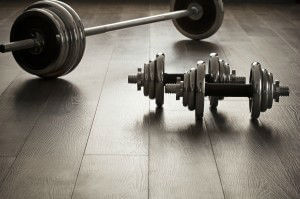
If you’re like most Americans, you probably think that you need to do intense cardio several times per week if you want to lose fat. You might hit the treadmill, elliptical, or pool in attempts to get your heart rate up and burn as many calories as possible.
However, new research comparing cardio and resistance training is casting some doubt on whether cardio really is best for fat burning. A recent interview with Pat Davidson, former Exercise Science Professor and Director at Peak Performance Gym, sheds some light on the issue.
This hot topic became even hotter when a recent study out of Harvard University showed that men who completed 20 minutes of strength training per day lost more fat than men who completed 20 minutes of cardio. These results flew in the face of common ideas surrounding fat loss, with many experts and exercisers believing that weight loss requires intense cardio, which is credited with boosting ones heart rate, which allows the body to burn fat more efficiently.
Exercisers usually think of cardio exercise and weight lifting as supplementing one another, but ultimately being opposites: cardio burns the fat, while weight lifting builds the sexy muscles that will emerge once we’ve burned the fat. According to Davidson, however, weight lifting, or ‘resistance training,’ has its own role to play in fat loss.
Davidson explains that the major variable when it comes to how much fat the body stores is insulin levels. If we can lower insulin levels, he suggests, we can increase fat loss. In fact, he proposes that out of control insulin levels are the main cause of the “diabesity” epidemic in the US that is keeping people fat and unhealthy.
So, how does this work?
Insulin is a natural chemical that moves nutrients like sugar, fats, and proteins into the body’s cells so that we can use them as energy. When insulin levels are too high, it prevents the body from burning off nutrients like fat and sugar. However, when levels of insulin are low, these nutrients can move out of storage, and it becomes possible to burn them off.
The primary variable associated with your insulin levels is your blood glucose, or blood sugar level. When your blood glucose rises, your pancreas secretes more insulin.
Resistance training lowers glucose levels more effectively than cardio because it stimulates the utilization of our ‘faster twitch muscle fibers.’ Faster twitch muscle fibers are the muscle fibers activated during exercises that require your body to exert a lot of force, like weightlifting and resistance training.
These muscles use glucose as a fuel source, thus when you perform these forceful movements you fatigue these fibers, and they turn to your glucose stores to repair themselves. This effectively lowers glucose levels in the body, and in turn allows the body to burn fat.
‘Slower twitch muscle fibers,’ on the other hand, which are activated during cardio, use fat as a fuel source. While cardio may therefore burn more fat in the short run, only doing cardio may not address the overall problem of insulin and high glucose levels, which may be causing the body to store fat.
 Davidson suggests that the best movements for activating the fat loss process are movements that use the whole body, and require you to exert a lot of force. He calls them ‘multi-joint resistance training exercises,’ examples being deadlifts, squats, and pull-ups.
Davidson suggests that the best movements for activating the fat loss process are movements that use the whole body, and require you to exert a lot of force. He calls them ‘multi-joint resistance training exercises,’ examples being deadlifts, squats, and pull-ups.
Lifting movements that target smaller parts of the body, on the other hand, don’t require enough force to lead to fat loss. The more of your body used, the more force will go up, and the lower glucose levels will go.
However, in terms of which is ‘best’ overall, Davidson doesn’t provide a clear answer. Instead, he provides us with a conclusion we probably all know to be true but hate to admit to ourselves. He says: “You probably need to do the thing that you’re not currently doing.”
Indeed, balance is always key. So, if cardio is currently your only or primary workout, it’s probably time to introduce some weight or resistance training – and vice versa.
-The Alternative Daily
Sources:
http://www.huffingtonpost.com/2015/01/30/cardio-or-weights-strength-fat_n_6572342.html?ir=Healthy+Living
http://www.obesity.org/publications/obesity-journal.htm
http://www.womenshealthmag.com/weight-loss/cardio-vs-weight-training

